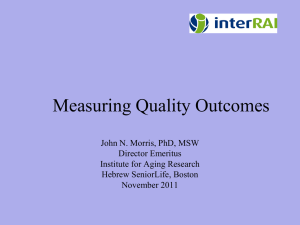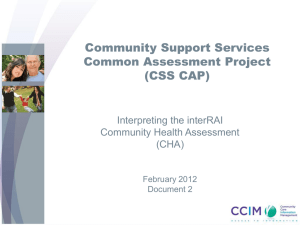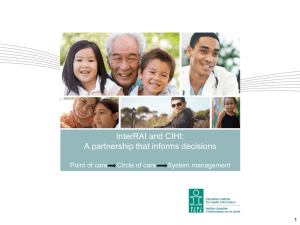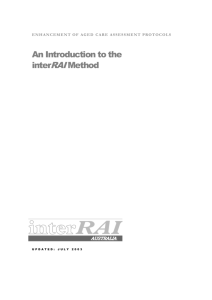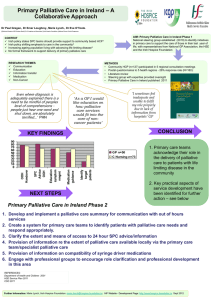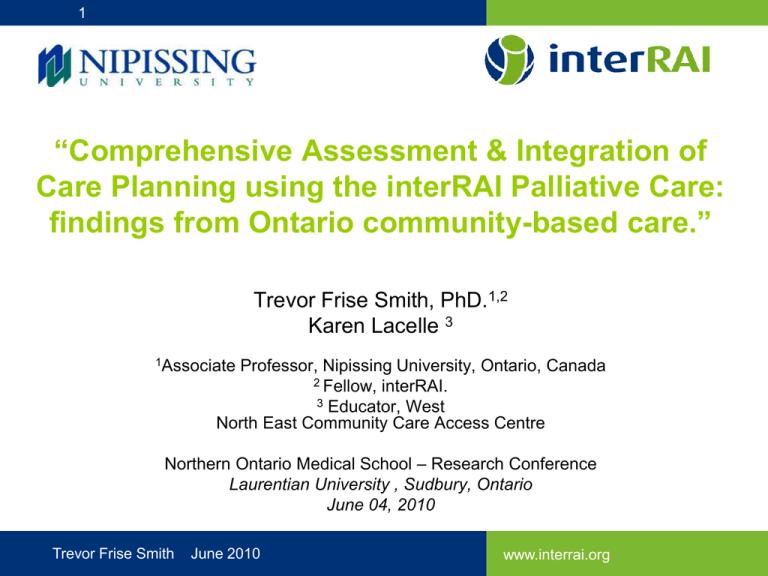
1
“Comprehensive Assessment & Integration of
Care Planning using the interRAI Palliative Care:
findings from Ontario community-based care.”
Trevor Frise Smith, PhD.1,2
Karen Lacelle 3
1Associate
Professor, Nipissing University, Ontario, Canada
2 Fellow, interRAI.
3 Educator, West
North East Community Care Access Centre
Northern Ontario Medical School – Research Conference
Laurentian University , Sudbury, Ontario
June 04, 2010
Trevor Frise Smith
June 2010
www.interrai.org
2
Agenda
• Brief introduction to interRAI and the
interRAI Palliative Care
• Use of the interRAI PC in Ontario
• Care Planning – caregiver distress
Trevor Frise Smith
June 2010
www.interrai.org
3
“Now that you mention it doctor …. symptom reporting
and the need for systematic questioning in a specialist
palliative care unit”
• Study by White, McMullan
& Doyle, J of Pall Med (12)
2009.
• Compared symptom selfreport with systematic
questioning.
• 2/3 of symptoms
experienced by
patient were not
self-report.
Trevor Frise Smith
June 2010
www.interrai.org
4
interRAI
• Non-profit organization
• International group of clinicians & researchers
• Develop standardized assessment instruments for (mainly) nonacute care
• Use as “admission or intake” assessment.
• Focus upon client functioning, needs, resources.
• Not diagnosis
• Meets twice a year
• Science (e.g., cross-national comparisons)
• Instrument development
• Support implementation in other nations
• Holds copyright to RAI assessment instruments
• Grants royalty-free licenses to governments and care providers
• www.interrai.org
Trevor Frise Smith
June 2010
www.interrai.org
5
interRAI develops “clinical support” tools
• Not automated, computerized care
planning
• Rather, client-level information, can be
computerized, then used to assist care planning
• Not diagnostic tools
• Not automatic decision tools
• Rather - help with decision making, assist care
planning.
Trevor Frise Smith
June 2010
www.interrai.org
6
•
•
•
•
Criteria for Adding Items on
Assessment Form
Care planning “trigger”
Outcomes assessment
Quality indicator
Case-mix grouper
• In addition:
• Fewest number of items for “trigger”
• All items, research / clinical based
• Ongoing validity & reliability assessment
Trevor Frise Smith
June 2010
www.interrai.org
Provincial Implementation of
interRAI Instruments in Ontario
Instrument
Setting
Date of
Implementation
Population
Number of
assessments
RAI-Home Care
(RAI-HC)
•CCAC
(Community)
•CCAC
(Hospital)
•2003
•Long Stay
•1,100,000
•2004
•Pts awaiting
LTC
•60,000
Contact
Assessment (CA)
•CCAC
(Intakes)
•Initial
implementation
in 2006
•Hosp inpt
•Hosp outpt
•Community
•24,000
•10,000
•28,000
RAI-Mental Health
(RAI-MH)
•Inpatient
Psychiatry
•2005
•All pts
•350,000
RAI 2.0
•CCC
•LTC
•1996
•All pts
•Underway since •All residents
2005
Hirdes May 2010
www.interrai.org
•356,000
•73,000
8
In Ontario - - CCAC sites in 6 (red) of
the 14 Local Health Integration Networks (LHINs) have
(will have) adopted the interRAI PC.
•
•
•
•
•
•
•
•
•
•
•
•
•
•
Trevor Frise Smith
June 2010
LHIN-1 (Erie St. Clair)
LHIN-2 (South West)
LHIN-3 (Waterloo Wellington)
LHIN-4 (Hamilton Niagara HaldiBrant)
LHIN-5 (Central West)
LHIN-6 (Mississauga Halton)
LHIN-7 (Toronto Central)
LHIN-8 (Central)
LHIN-9 (Central East)
LHIN-10 (South East)
LHIN-11 (Champlain)
LHIN-12 (North Simcoe Muskoka)
LHIN-13 (North East)
LHIN-14 (North West)
www.interrai.org
9
interRAI PC Domains
version 2006 (9)
• Identification &
Intake/initial hx
• Health conditions
• Oral/nutritional status
• Skin conditions
• Cognition
• Communication
• Mood & Behaviour
• Psychosocial well-being
Trevor Frise Smith
June 2010
•
•
•
•
•
•
•
•
Physical functioning
Continence
Medications
Treatments &
procedures
Responsibilities /
directives
Social supports
Discharge info
Assessor info
www.interrai.org
10
Trevor Frise Smith
June 2010
www.interrai.org
11
Trevor Frise Smith
June 2010
www.interrai.org
12
Caregiving Patterns and
Caregiver Distress Among
Community Palliative Care
Clients
Trevor Frise Smith
June 2010
www.interrai.org
Percent Palliative
Home Care Clients
13
Sex and Marital Status of Palliative Home Care
Clients, Ontario, 2006-2008
100
75
60
50
52
48
24
25
9
7
Separated/
Divorced
Never
Married
0
Male
Trevor Frise Smith
Female
June 2010
Married/
Partner
Widowed
www.interrai.org
14
Percentage of Palliative Home Care Clients
Diagnosed with Cancer, Ontario, 2006-2008
No Cancer
Trevor Frise Smith
June 2010
www.interrai.org
Cancer
15
Top 10 Cancer Diagnoses (4a) and Non-Cancer Diagnoses
(4b) of Palliative Home Care Clients, Ontario, 2006-2008
Trevor Frise Smith
June 2010
www.interrai.org
16
Indicators of Caregiver Distress1 among Informal Caregivers of
Palliative Home Care Clients, Ontario, 2006-2008
Percent Clients with
Distressed Caregivers
100
77
75
50
25
11
8
1
2
4
0
0
3
Number of Indicators of Caregiver Distress
Indicators of caregiver distress include: helper(s) unable to continue caring activities;
primary informal helper expresses feelings of distress, anger, or depression; family or
close friends report feeling overwhelmed by person's illness.
1
Trevor Frise Smith
June 2010
www.interrai.org
17
Palliative Home Care - Ontario
Trevor Frise Smith
June 2010
www.interrai.org
18
Percentage of Palliative Home Care Clients with Distressed
Caregivers1 by Estimated Prognosis2, Ontario, 2006-2008
Percent Clients wih
Distressed Caregivers
50
42
41
40
30
27
20
16
10
0
Death Imminent
(within days)
Less than
6 weeks
6 weeks to 6 months
6 months
or longer
Estimated Prognosis of Palliative Home Care Client
Trevor Frise Smith
June 2010
www.interrai.org
19
Percentage of Palliative Home Care Clients with Distressed
Caregivers1 by Unstable Health2, Ontario, 2006-2008
Percent Clients with
Distressed Caregivers
50
41
40
35
30
20
10
10
18
20
2
3
12
0
0
1
4
Stable
Highly
Unstable
Palliative Home Care Client Health Instability
Trevor Frise Smith
June 2010
5
www.interrai.org
20
Percentage of Palliative Home Care Clients with Distressed Caregivers1
by Level of Physical and Cognitive Performance2,3 ,Ontario, 2006-2008
50
Percent Clients with
Distressed Caregivers
40
30
20
10
0
0
1
2
3
4
5
Independent
Physical Performance
Trevor Frise Smith
June 2010
6
Severely Impaired
Cognitive Performance
www.interrai.org
21
Percentage of Palliative Home Care Clients with Distressed Caregivers1 by
Count of Gastro-Intestinal Problems2 and Count of Nutritional Issues3,
Ontario, 2006-2008
Percent Clients with
Distressed Caregivers
50
47
40
31
30
30
27
25
21
18
20
21
10
0
0 to 2
3 to 4
5+
Number of GI Issues3
Trevor Frise Smith
June 2010
0
1
2
3
4+
Number of Nutritional Issues3
www.interrai.org
22
Percentage of Palliative Home Care Clients with Distressed
Caregivers1 by Status of Dyspnea and Adequacy of Pain Control,
Ontario, 2006-2008
Percent Clients with
Distressed Caregivers
50
40
29
30
26
21
21
20
10
0
Not Present
Present
Dyspnea
Trevor Frise Smith
June 2010
Adequate
Inadequate
Pain Control
www.interrai.org
23
Percentage of Palliative Home Care Clients with Distressed Caregivers1
by Indicators of Potential Depression, Ontario, 2006-2008
48
50
Percent Clients with
Distressed Caregivers
42
40
36
30
20
15
10
0
Little/No Risk of
Depression
Moderate Risk of
Depression
High Risk of
Depression
Very High Risk of
Depression
Depressive Symptoms of Palliative Home Care Client
Trevor Frise Smith
June 2010
www.interrai.org
24
Percentage of Palliative Home Care Clients with Distressed Caregivers1
by Hours of Informal Care Received over last 3 days, Ontario, 2006-2008
Percent Clients with
Distressed Caregivers
50
40
30
30
32
19 to 36
37 or more
21
20
16
12
10
0
less than 3
3 to 9
10 to 18
Hours of Informal Care
Trevor Frise Smith
June 2010
www.interrai.org
25
Percentage of Palliative Home Care Client's with Distressed Caregivers1
by Palliative Home Care Client's Perspectives on Life, Ontario, 2006-2008
Percent Clients with
Distressed Caregivers
50
40
40
40
35
30
26
18
20
20
18
18
10
0
Struggling with
the Meaning of
Life
Wish to Die Now
No
Trevor Frise Smith
June 2010
Accepting of
the Situation
Consistent
Positive
Outlook
Yes
www.interrai.org
26
Self-reported sadness, depression by
“wish to die now”
Trevor Frise Smith
June 2010
www.interrai.org
27
Implications for Policy and Practice
• interRAI PC may be used to identify clients and
caregivers at risk of adverse outcomes and distress
• Seven CCACs have begun to use PC, and OACCAC
plans to expand to province wide implementation
• Many predictors of caregiver distress may be
manageable through good quality care to the palliative
client
• Palliative care appears to be a restricted service that
reaches mainly cancer patients
• Need to consider equity of access for persons dying
due to other causes
Trevor Frise Smith
June 2010
www.interrai.org
28
Thank You!
Questions or Comments?
Trevor Frise Smith
June 2010
www.interrai.org

